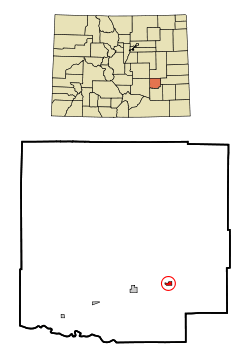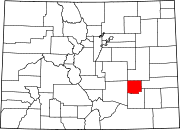Sugar City, Colorado
| Town of Sugar City, Colorado | |
|---|---|
| Town | |
 Location in Crowley County and the state of Colorado | |
| Coordinates: 38°13′55″N 103°39′53″W / 38.23194°N 103.66472°WCoordinates: 38°13′55″N 103°39′53″W / 38.23194°N 103.66472°W | |
| Country |
|
| State |
|
| County[1] | Crowley County |
| Incorporated | July 2, 1900[2] |
| Government | |
| • Type | Statutory Town[1] |
| Area | |
| • Total | 0.4 sq mi (1.0 km2) |
| • Land | 0.4 sq mi (1.0 km2) |
| • Water | 0 sq mi (0 km2) |
| Elevation[3] | 4,304 ft (1,312 m) |
| Population (2010) | |
| • Total | 258 |
| • Density | 670/sq mi (258.8/km2) |
| Time zone | Mountain (MST) (UTC-7) |
| • Summer (DST) | MDT (UTC-6) |
| ZIP code[4] | 81076 |
| Area code(s) | 719 |
| FIPS code | 08-74815 |
| GNIS feature ID | 0195392 |
Sugar City is a Statutory Town in Crowley County, Colorado, United States. The population was 258 at the 2010 census.[5]
A post office called Sugar City has been in operation since 1900.[6] The community was named for the fact it once was a sugar manufacturing center.[7]
Geography
Sugar City is located in southeastern Crowley County at 38°13′55″N 103°39′53″W / 38.23194°N 103.66472°W (38.231866, -103.664851).[8] Colorado State Highway 96 leads west 5 miles (8 km) to Ordway, the county seat, and northeast 33 miles (53 km) to Haswell.
According to the United States Census Bureau, Sugar City has a total area of 0.4 square miles (1.0 km2), all of it land.
Demographics
| Historical population | |||
|---|---|---|---|
| Census | Pop. | %± | |
| 1900 | 689 | — | |
| 1910 | 808 | 17.3% | |
| 1920 | 836 | 3.5% | |
| 1930 | 598 | −28.5% | |
| 1940 | 565 | −5.5% | |
| 1950 | 527 | −6.7% | |
| 1960 | 409 | −22.4% | |
| 1970 | 307 | −24.9% | |
| 1980 | 306 | −0.3% | |
| 1990 | 252 | −17.6% | |
| 2000 | 279 | 10.7% | |
| 2010 | 258 | −7.5% | |
| Est. 2015 | 248 | [9] | −3.9% |
As of the census[11] of 2000, there were 279 people, 117 households, and 78 families residing in the town. The population density was 724.9 people per square mile (283.5/km²). There were 147 housing units at an average density of 382.0 per square mile (149.4/km²). The racial makeup of the town was 88.89% White, 3.58% Native American, 1.08% Asian, 3.23% from other races, and 3.23% from two or more races. Hispanic or Latino of any race were 13.98% of the population.
There were 117 households out of which 28.2% had children under the age of 18 living with them, 53.8% were married couples living together, 9.4% had a female householder with no husband present, and 33.3% were non-families. 28.2% of all households were made up of individuals and 12.8% had someone living alone who was 65 years of age or older. The average household size was 2.38 and the average family size was 2.97.
In the town the population was spread out with 26.2% under the age of 18, 5.0% from 18 to 24, 24.7% from 25 to 44, 25.4% from 45 to 64, and 18.6% who were 65 years of age or older. The median age was 42 years. For every 100 females there were 87.2 males. For every 100 females age 18 and over, there were 85.6 males.
The median income for a household in the town was $25,208, and the median income for a family was $27,500. Males had a median income of $27,813 versus $18,750 for females. The per capita income for the town was $12,564. About 12.9% of families and 19.6% of the population were below the poverty line, including 30.5% of those under the age of eighteen and 5.8% of those sixty five or over.
History
Sugar City was named for its sugar beet factory, which closed in 1967.[12]
See also
References
- 1 2 "Active Colorado Municipalities". State of Colorado, Department of Local Affairs. Retrieved 2007-09-01.
- ↑ "Colorado Municipal Incorporations". State of Colorado, Department of Personnel & Administration, Colorado State Archives. 2004-12-01. Retrieved 2007-09-02.
- ↑ "US Board on Geographic Names". United States Geological Survey. 2007-10-25. Retrieved 2008-01-31.
- ↑ "ZIP Code Lookup" (JavaScript/HTML). United States Postal Service. Retrieved 2008-01-06.
- ↑ "Geographic Identifiers: 2010 Demographic Profile Data (G001): Sugar City town, Colorado". U.S. Census Bureau, American Factfinder. Retrieved June 24, 2014.
- ↑ "Post offices". Jim Forte Postal History. Retrieved 11 July 2016.
- ↑ Dawson, John Frank. Place names in Colorado: why 700 communities were so named, 150 of Spanish or Indian origin. Denver, CO: The J. Frank Dawson Publishing Co. p. 48.
- ↑ "US Gazetteer files: 2010, 2000, and 1990". United States Census Bureau. 2011-02-12. Retrieved 2011-04-23.
- ↑ "Annual Estimates of the Resident Population for Incorporated Places: April 1, 2010 to July 1, 2015". Retrieved July 2, 2016.
- ↑ "Census of Population and Housing". Census.gov. Retrieved June 4, 2015.
- ↑ "American FactFinder". United States Census Bureau. Retrieved 2008-01-31.
- ↑ "Colorado.com". Retrieved 2012-10-23.

